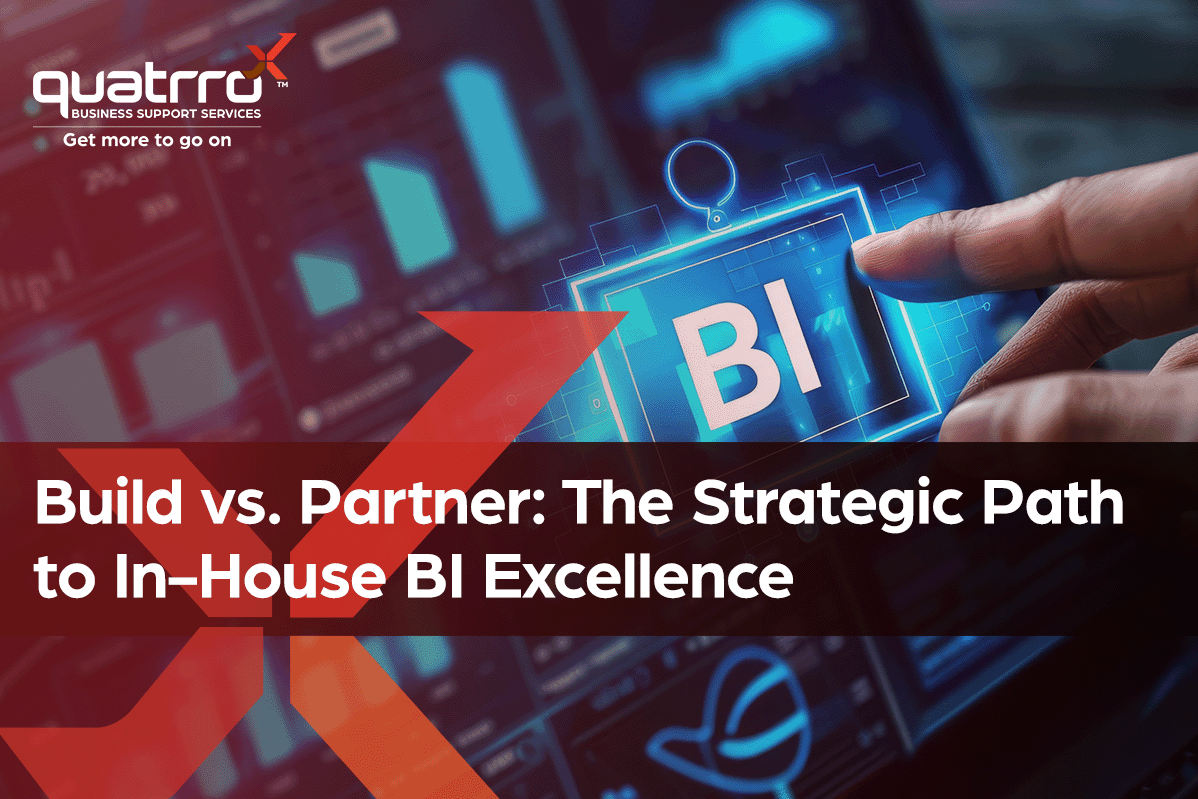Blog Details
Build vs. Partner: The Strategic Path to In- House BI Excellence
July 17, 2025

Every organization eventually needs dedicated BI resources — call it a data team, reporting team, or analytics function. The real question isn’t whether you should build this capability, but how quickly you can move from zero to operational excellence.
Common Build-From-Scratch Challenges:
Key Partnership Advantages:
Partner teams build core infrastructure, data pipelines, and initial reporting capabilities. This phase delivers immediate business value while establishing scalable architecture and automated workflows.
Phase 2: Stabilize & Enhance (Months 13-24)
Ongoing support maintains system stability, resolves issues quickly, and adds incremental enhancements. Continuity with the original team ensures efficient maintenance without disrupting business users.
Phase 3: Strategic Handoff (Years 25-36)
The organization hires senior internal BI resources—data architects or reporting managers—who inherit fully documented, well-architected systems. New hires focus on strategic growth and advanced analytics rather than reworking foundational systems.
Indicators for Internal Transition:
Months 7-18: Capability expansion, process optimization, and ongoing maintenance by partner
Months 19-36: Strategic handoff planning from partner and internal hiring preparation
Year 3+: Internal ownership with partner support for major initiatives
This model provides the best of both approaches: rapid capability development through partnership expertise, followed by sustainable internal ownership of proven systems.
Ready to accelerate your BI journey? Evaluate whether your current timelines and internal resource availability align with partnership advantages or full internal build.
The Reality of BI Team Development
Building internal BI capabilities from scratch often takes 18–24 months and significant upfront investment — not just in technology, but in people, processes, and organizational alignment. Companies must hire specialized talent, navigate fragmented systems, and define consistent standards for data governance, development, and collaboration — all while the business still expects timely insights.Common Build-From-Scratch Challenges:
- Competing for qualified data architects and BI developers in a limited talent market
- Long ramp-up periods (6-12 months) for new hires to understand business context
- Costly trial-and-error approach to tool selection and architecture decisions
- Complex integrations with legacy systems and undocumented interfaces
The Acceleration Model: Partner to Independence
Strategic BI partnerships offer an alternative path: compressing timelines, avoiding costly missteps, and building internal capabilities in parallel. Rather than learning through trial-and-error, companies leverage accumulated experience across industries, technologies, and data environments to move faster while setting a strong long-term foundation.Key Partnership Advantages:
- Thousands of hours of practical experience across diverse technical environments
- Proven methodologies for extracting and integrating data from legacy or disconnected systems
- Quick resolution of integration, modeling, and architecture issues that may stall internal teams
- Immediate access to senior-level expertise without long hiring cycles
- Playbooks, standards, and frameworks that establish sustainable internal processes
Structured Transition Strategy
Phase 1: Rapid Build (Months 1-12)Partner teams build core infrastructure, data pipelines, and initial reporting capabilities. This phase delivers immediate business value while establishing scalable architecture and automated workflows.
Phase 2: Stabilize & Enhance (Months 13-24)
Ongoing support maintains system stability, resolves issues quickly, and adds incremental enhancements. Continuity with the original team ensures efficient maintenance without disrupting business users.
Phase 3: Strategic Handoff (Years 25-36)
The organization hires senior internal BI resources—data architects or reporting managers—who inherit fully documented, well-architected systems. New hires focus on strategic growth and advanced analytics rather than reworking foundational systems.
Optimal Timing for Internal Transition
The handoff timeline varies based on organizational complexity and growth trajectory, but most organizations benefit from 2-3 years of partnership before full internal ownership.Indicators for Internal Transition:
- Stable BI infrastructure with documented systems, processes, and workflows
- Clear definition of maintenance responsibilities and resource needs
- Business growth justifying dedicated internal headcount
- Availability of qualified senior-level BI talent in the market
Cost-Benefit Analysis: Partnership vs. Internal Build
Internal Build Cost Expectations (Year 1):- 6-12 months for team ramp-up and full productivity
- Senior Data Architect: $120-150K + benefits
- BI Developer: $90-110K + benefits
- Tool licensing and infrastructure setup: $120K–195K
- Includes Power BI Premium, cloud data warehouse, ETL tools, cloud compute/storage, and admin/monitoring software
- Management overhead for hiring, onboarding, and coordination
- Immediate access to senior-level expertise at lower cost
- Predictable monthly pricing tied to defined deliverables
- No hiring risks or management overhead
- Proven frameworks that accelerate delivery timelines
- Built-in knowledge transfer and fully documented systems
Making the Strategic Decision
Partnership models are ideal for organizations facing:- Compressed timelines for BI implementation
- Limited internal technical expertise or talent availability
- Complex integration with legacy or disconnected systems
- Uncertainty about long-term BI staffing needs
- Private equity ownership with defined exit horizons
Implementation Framework
Months 1-6: Core infrastructure build and initial reporting automation led by partnerMonths 7-18: Capability expansion, process optimization, and ongoing maintenance by partner
Months 19-36: Strategic handoff planning from partner and internal hiring preparation
Year 3+: Internal ownership with partner support for major initiatives
This model provides the best of both approaches: rapid capability development through partnership expertise, followed by sustainable internal ownership of proven systems.
Next Steps: Evaluating Your BI Strategy
Consider your organization’s current position: timeline pressures, internal capabilities, and long-term strategic goals. The partnership-to-internal model is ideal for organizations needing rapid BI development while building toward sustainable internal ownership.Ready to accelerate your BI journey? Evaluate whether your current timelines and internal resource availability align with partnership advantages or full internal build.
Latest Insights
Related Blogs
Contact Us








